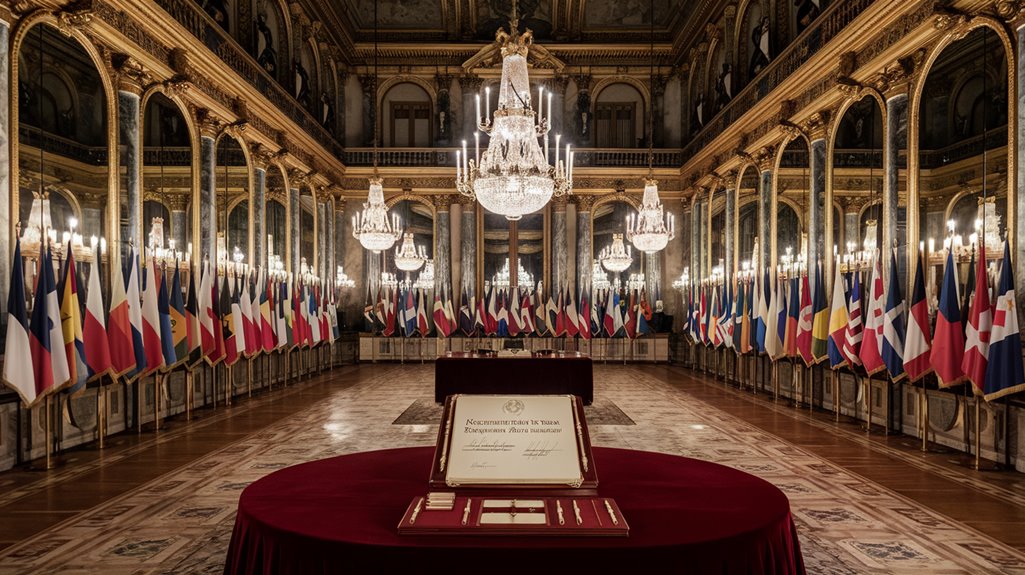Over 60 Countries Signed an Agreement to Outlaw War After WWI
You've probably heard about countless peace treaties throughout history, but here's one that stands out: in 1928, over 60 nations actually tried to make war illegal. Yes, you read that correctly. The Kellogg-Briand Pact represented humanity's most ambitious attempt to banish warfare after the horrors of World War I. While it may sound naive today, this remarkable agreement reveals much about the hope, desperation, and determination of a world still reeling from unprecedented destruction.
The Birth of the Kellogg-Briand Pact

Following the devastation of World War I, a groundbreaking diplomatic initiative emerged in 1928 known as the Kellogg-Briand Pact. You might be surprised to learn that this historic agreement began as a simple proposal between France and the United States before expanding into something much larger.
The pact's significance grew when U.S. Secretary of State Frank B. Kellogg transformed French Minister Aristide Briand's initial bilateral proposal into a multinational treaty. The signatories committed to renounce war completely as an instrument of national policy. The treaty emphasized peaceful dispute settlement through diplomatic channels and arbitration.
Through intense diplomatic negotiations, fifteen nations, including major powers like Germany, France, the United States, and the United Kingdom, signed the agreement in Paris on August 27, 1928.
Within a year, the number of signatories grew to 62 countries. The U.S. Senate showed its support by ratifying the treaty in January 1929.
Key Terms and Promises of the Agreement
The Kellogg-Briand Pact stood on two fundamental pillars: the complete renunciation of war as a tool of national policy and a commitment to peaceful dispute resolution. Among its key principles, you'll find that signatory nations agreed to settle all their disputes through peaceful means, regardless of the conflict's nature or intensity.
However, the pact had significant limitations. While it outlined noble intentions, you won't find any enforcement mechanisms within its text. The pact emerged from a collaboration between Frank Billings Kellogg and Aristide Briand to promote peace-keeping measures. There weren't any specified consequences for nations that might violate the agreement, making it largely symbolic.
The treaty did allow for self-defense and compliance with other post-war treaties, but these exceptions created loopholes that aggressive nations could exploit. Despite these weaknesses, the pact established important international norms that would later influence the United Nations Charter. Initially proposed as a bilateral agreement between France and the United States, the pact expanded to include fifteen initial signatories before growing significantly.
World Leaders Behind the Historic Treaty
While the pact's principles laid important groundwork, its creation stemmed from the dedicated efforts of several world leaders. French Foreign Minister Aristide Briand and U.S. Secretary of State Frank B. Kellogg led the diplomatic negotiations that culminated in the historic agreement. Their collaboration helped secure the initial commitment of 15 nations to renounce war as a tool of national policy.
The treaty implications went far beyond its original signatories. Wilson's pursuit of lasting world peace through international cooperation had set an important precedent for this agreement.
You'll find it interesting that this pact emerged just a decade after the Treaty of Versailles, which had brought together the "Big Four" – Wilson, Clemenceau, Lloyd George, and Orlando – to reshape Europe after WWI.
While the Versailles Treaty focused on war reparations and territorial changes, the Kellogg-Briand Pact aimed to prevent future conflicts altogether.
Global Response and Initial Optimism
Popular support for peace after World War I's devastating toll helped propel the Kellogg-Briand Pact to widespread acceptance, with 68 nations ultimately signing the agreement.
Public sentiment played a significant role, as citizens worldwide pressured their governments to embrace this new commitment to peace. After experiencing heavy reparations, Germany's participation highlighted the universal desire to prevent future conflicts. The pact's appeal stemmed from its straightforward promise to outlaw war as an instrument of national policy. The initiative began when French Minister Aristide Briand proposed a bilateral treaty between France and the United States in 1927.
You'll find that international cooperation reached new heights as major powers, including Germany and Japan, joined the effort.
The world felt a surge of optimism that this agreement would prevent another global conflict. While the pact lacked enforcement mechanisms, the force of public opinion and the shared desire to avoid another devastating war created momentum for this historic step toward international peace.
The Legacy and Lessons of a Noble Attempt

Despite its noble aspirations, the Kellogg-Briand Pact's failure offers essential lessons about international peace agreements.
You'll find that its idealistic failures stemmed primarily from the lack of concrete enforcement mechanisms, allowing aggressive nations to exploit its weaknesses. The pact's inability to define "self-defense" let countries justify their hostile actions without consequences. When problems arose, nations received error notifications but had no clear guidance on resolution.
Looking at its legacy, you can see how economic pressures during the Great Depression undermined international resolve to enforce the agreement. German citizens experienced harsh economic hardships in the post-WWI years, making them increasingly resistant to international controls.
The contrast with the Treaty of Versailles is telling – while Versailles had specific enforcement provisions, the Kellogg-Briand Pact's enforcement challenges made it ultimately ineffective.
These shortcomings have taught us that successful international agreements need clear definitions, strong enforcement mechanisms, and reliable collective action to maintain peace.










